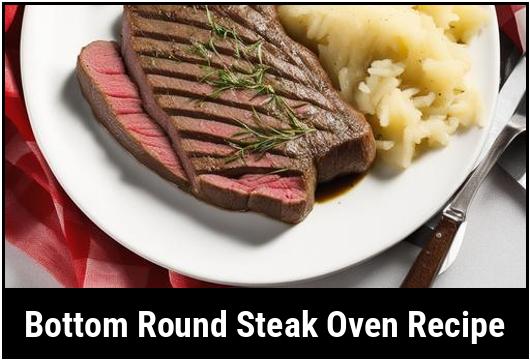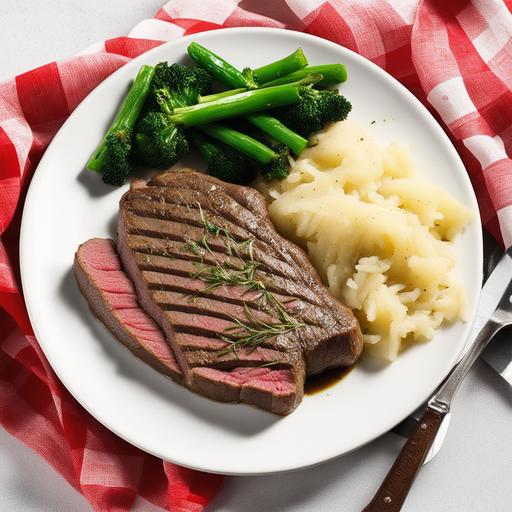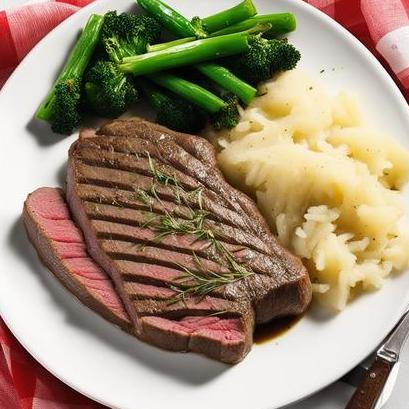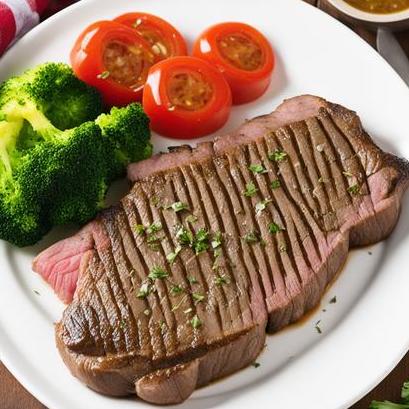
The Art Of Preparing Juicy And Flavorful Bottom Round Steak: A Comprehensive Guide To Oven Cooking
Are you looking for a delicious and budget-friendly cut of beef that can be prepared effortlessly in the oven? Look no further than bottom round steak! This underrated meat, also known as rump roast or round roast, can be transformed into a mouthwatering meal with the right techniques and flavors. In this comprehensive guide, we will explore the science, culinary secrets, selection, cleaning, preparation, cooking tips, variations, doneness checks, and everything else you need to know to achieve a perfectly cooked bottom round steak. So, let’s dive into the world of culinary excellence!
Understanding the Science: Why Bottom Round Steak is Unique
Bottom round steak originates from the hindquarters of the cow, which means it is relatively lean compared to other cuts. It consists of well-used muscles, resulting in a flavorful, albeit slightly tougher meat. However, with the proper cooking method, it can become tender and succulent. Understanding the science behind this transformation is essential to achieve a remarkable dish.
When bottom round steak is exposed to heat, the tough connective tissues known as collagen slowly break down, resulting in tenderized meat. This process, called collagen denaturation, requires low temperature, long cooking times, and moisture retention to effectively occur. We will explore these aspects in the cooking process to make sure your bottom round steak turns out nothing short of extraordinary.
Selecting the Perfect Bottom Round Steak
Selecting the right piece of bottom round steak is crucial for a successful culinary endeavor. Here are some tips to keep in mind when choosing your meat:
-
Favor thickness: Aim for steaks that are at least 1 inch thick, as thinner cuts tend to dry out easily during cooking.
-
Marbling: Look for a balance between lean meat and a modest amount of marbling, as this will enhance the flavor and tenderness of the steak.
-
Color and texture: Ideally, select a steak that exhibits a vibrant, cherry-red color and a silky-smooth texture. Avoid those with discoloration or excessive moisture.
Cleaning and Preparing Bottom Round Steak

Once you’ve brought home your prime bottom round steak, it’s time to prepare it for the cooking process. Follow the steps below to ensure your meat is clean and ready for the oven:
Step 1: Unpackaging the steak
Start by carefully removing the steak from its packaging. Allow it to rest on a clean plate at room temperature for approximately 30 minutes. This step ensures even cooking throughout the meat.
Step 2: Patting dry
Using paper towels, gently pat the steak dry to eliminate excess moisture. This will aid in the development of a beautiful crust during the cooking process.
Step 3: Seasoning
Now comes the fun part! Season both sides of the steak generously with your favorite combination of herbs, spices, and marinades. Some popular options include salt, black pepper, garlic powder, paprika, rosemary, and Worcestershire sauce. Let your creativity shine and experiment with different flavors!
Cooking Tips and Variations for Succulent Bottom Round Steak

Now that your bottom round steak is prepped and ready, it’s time to venture into the realm of oven cooking. Here are some cooking tips, variations, and creative ideas to elevate your dish:
1. Dry Rub Marination:
Rather than relying solely on liquid-based marinades, you can create a dry rub by combining spices like cumin, chili powder, brown sugar, and cayenne pepper. Massage this mixture into the steak for a few minutes, allowing the flavors to infuse deeply into the meat. Let the seasoned steak rest in the refrigerator for at least 1 hour, or ideally overnight, before cooking.
2. Slow and Low Roasting:
Given the characteristics of bottom round steak, slow roasting at a low temperature is highly recommended. Preheat your oven to 275°F (135°C) for maximum tenderness. Coating the steak with a thin layer of oil or melted butter before roasting will help retain moisture and promote browning.
3. Moisture Retention Techniques:
To prevent the steak from drying out during the cooking process, you can employ several techniques such as cooking it with aromatic vegetables (onions, carrots, etc.) or placing it on a bed of herbs like thyme or rosemary. The vegetables and herbs release moisture, creating a moist cooking environment.
4. Reverse Searing Method:
For those seeking a beautiful medium-rare or medium doneness, consider using the reverse searing method. Begin by roasting the steak at a low temperature of 250°F (120°C) until it reaches an internal temperature of about 10°F (5°C) below your desired doneness. Then, sear the steak on a hot stovetop or grill for a couple of minutes per side to achieve a delightful crust.
Checking for Doneness and the Pitfall of Overcooking/Undercooking

Determining the doneness of your steak is crucial to achieve the perfect balance between tenderness and flavor. While personal preferences may vary, here are some general guidelines on how to check for doneness:
1. Meat Thermometer:
Investing in a reliable instant-read meat thermometer is a game-changer when cooking steak. Refer to the following temperature guide for different levels of doneness:
-
Rare: 125°F (52°C)
-
Medium Rare: 135°F (57°C)
-
Medium: 145°F (63°C)
-
Medium Well: 155°F (68°C)
-
Well Done: 160°F (71°C) and above
2. Finger Test:
For those who prefer a more tactile approach, you can use the finger test, also known as the touch test. Gently press the center of the steak with your finger and compare the resistance to various parts of your hand. As you gain experience, this method becomes an accurate way to gauge doneness.
3. Resting Period:
After achieving the desired doneness, remove the steak from the oven and let it rest on a cutting board. Cover it loosely with foil, allowing the residual heat to redistribute within the meat and the juices to settle. A resting period of 5-10 minutes is recommended before slicing. This step helps to retain the juiciness of the steak.
A Flavorful Recipe to Delight Your Senses

To put your newfound knowledge into practice, here’s a mouthwatering recipe that will impress your family and friends. Get ready to savor a deliciously tender bottom round steak cooked to perfection:
Ingredients:
-
2 lbs (900g) bottom round steak
-
2 tablespoons olive oil
-
4 garlic cloves, minced
-
1 tablespoon fresh rosemary, chopped
-
1 tablespoon fresh thyme leaves
-
1 teaspoon salt
-
1 teaspoon black pepper
Directions:
-
Preheat your oven to 275°F (135°C).
-
In a small bowl, combine the minced garlic, chopped rosemary, thyme, salt, and black pepper.
-
Pat the bottom round steak dry with paper towels.
-
Rub the steak with the olive oil, ensuring all sides are coated.
-
Generously sprinkle the garlic and herb mixture over the steak, pressing it gently to adhere.
-
Place the steak on a baking rack set inside a roasting pan or directly onto a greased baking sheet.
-
Roast the bottom round steak in the preheated oven for approximately 90 minutes, or until the internal temperature reaches your desired doneness. Aim for an internal temperature of 135°F (57°C) for medium-rare or adjust according to your taste.
-
Remove the steak from the oven and allow it to rest, covered with foil, for at least 10 minutes.
-
Slice the steak against the grain into thin strips and serve.
Final Words of Encouragement
Congratulations! You have embarked on a culinary journey that explores the vast potential of bottom round steak cooked in the oven. By understanding the science, carefully selecting your meat, mastering the preparation, exploring cooking variations, and perfecting the doneness, you’ll be rewarded with a tender and flavorful steak that will impress even the most discerning palates.
Remember, every cooking endeavor is a learning experience. Don’t be discouraged by minor setbacks; instead, view them as stepping stones to refinement and mastery. Enjoy the process, embrace your creativity, and share your delicious creations with family and friends. Happy cooking, and savor every succulent bite of your perfectly prepared bottom round steak!
Sources
FAQS On Bottom Round Steak Oven Recipe
What Is A Bottom Round Steak?
A bottom round steak is a cut of beef from the round primal, which is located on the rear of the cow. It is a lean and tough cut that is best cooked low and slow to achieve tenderness.
How Should I Prepare A Bottom Round Steak For Cooking?
To prepare a bottom round steak for cooking, first make sure it is brought to room temperature. Next, trim any excess fat and make shallow cuts in a diamond pattern on both sides of the steak to help tenderize it. Season with your desired spices or marinade.
Can A Bottom Round Steak Be Cooked In The Oven?
Yes, a bottom round steak can be cooked in the oven. It is recommended to use a low and slow cooking method, such as roasting or braising, to help tenderize the meat and prevent it from becoming tough and chewy.
What Is The Recommended Internal Temperature For A Cooked Bottom Round Steak?
The USDA recommends cooking beef to an internal temperature of at least 145°F for medium rare, 160°F for medium, and 170°F for well done. Since the bottom round steak is a tougher cut, it is recommended to cook it to at least medium or medium well.
How Long Should A Bottom Round Steak Cook In The Oven?
The cooking time for a bottom round steak in the oven will vary depending on the size and thickness of the steak, as well as the desired level of doneness. In general, it can take anywhere from 20 minutes to an hour or more to cook in the oven at a low temperature (300°F or lower). It is recommended to use a meat thermometer to ensure the internal temperature reaches at least 145°F for medium rare.


